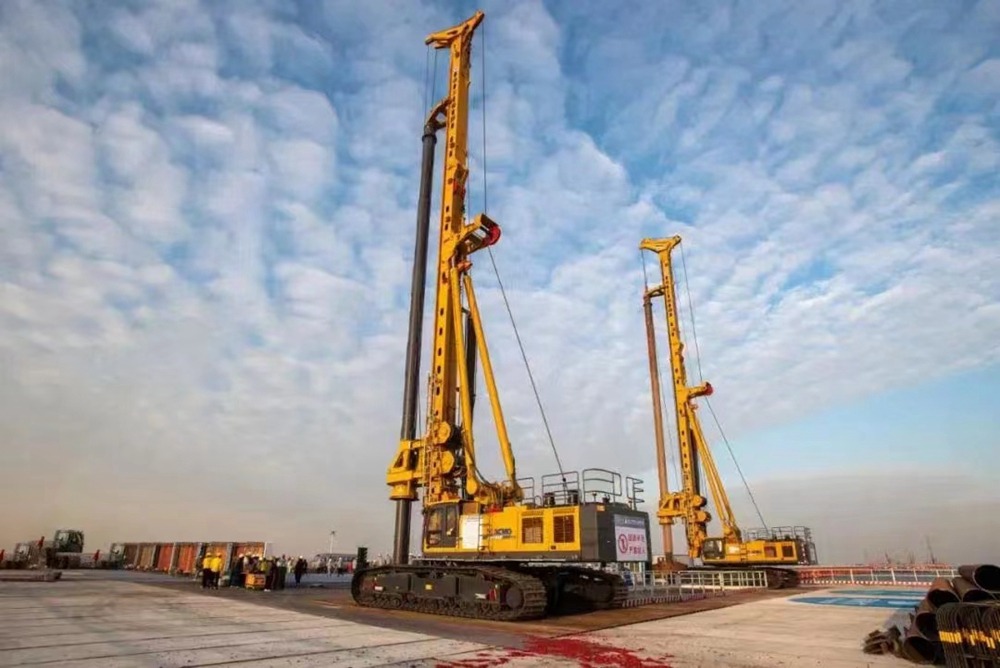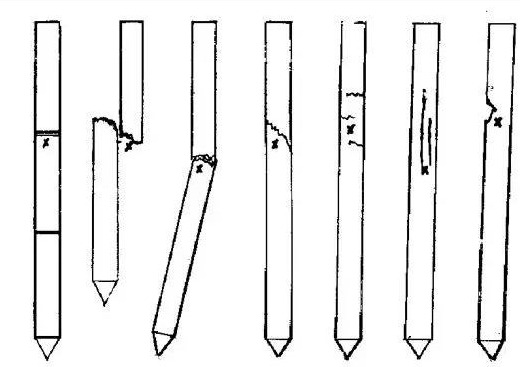With the continuous development of engineering technology, new steel piles and reinforced concrete piles are becoming more and more widely used in engineering construction. Different pile types also have different characteristics.
1. Classification according to stress conditions:
① Friction pile – a pile foundation pile in which most of the load is borne by the friction of the soil around the pile, while the resistance at the pile end is negligible.
②End-bearing friction pile–a pile whose load is mainly borne by the friction of the pile body
③End-bearing pile–most of the load is borne by the pile tip supporting force, and the pile side resistance is negligible.
④ Friction end-bearing pile–the load is mainly borne by the resistance of the pile end.
2. Classification according to construction method:
① Mechanical hole pile
② cast-in-place pile
③Manually dug piles
④Immersed tube cast-in-place pile
⑤Reinforced concrete piles
⑥Prefabricated piles
⑦Prestressed concrete piles
⑧Steel pile
⑨Cement and soil mixing pile
⑩Stirring pile
3. Other chemical material mixing piles
4. Classification according to the external dimensions of the piles
①Long pile
②Foundation pile
③Short pile
④Medium long pile
⑤Variable cross-section pile
5. Prefabricated piles can be divided into
①Driving piles
② Press-in pile
③Vibration sinking pile
④Screw in piles, etc.
★Prefabricated piles can be divided into ordinary reinforced concrete piles and prestressed reinforced concrete piles according to materials. According to the cross-sectional shape of piles, they can be divided into solid piles and hollow piles, round piles, square piles, special-shaped piles, etc.
★Pile connection methods include steel plate angle steel welding, flange and bolt connection, sulfur cement anchoring, and mechanical connection (such as wedge insertion, and pin connection), etc.
6. Concrete cast-in-place piles can be divided into
①Vibration immersed tube cast-in-place pile
② Frank pile
③The steel casing is screwed into the punched pile to form a hole.
④ Mud wall retaining hole cast-in-place pile
⑤Driving cast-in-place piles through pre-pressure holes
⑥Driving concrete piles through preloaded holes
⑦Drilling and expanding concrete cast-in-place piles
★Franck piles are very popular in Europe, and there are also projects constructed using this method in our country. This method is suitable for loose sand, gravel, and over-consolidated clay. The diameter of the pile body is 30-60cm, the length of the pile is 10-24m, the core hammer weight is 25-50kN, the drop distance is 3-5m, and the allowable bearing capacity of a single pile can reach 1500kN.. The cast-in-place pile is a cast-in-place pile that is sunk into a hole by a rotating steel pipe. The bottom of the steel pipe is equipped with quenched steel teeth. It can be sunk into the shale or sandstone layer with a diameter of up to 1.5 meters. Steel pipes are connected with flanges, and concrete piles driven into preloaded holes are a type of pile between driven piles and cast-in-place piles. The construction steps are to first drive the steel dowel rod into the soil 0.5 to 1.0m, then pull out the steel dowel rod, pour concrete or mortar into the hole, and then place a prefabricated reinforced concrete pile in the hole. , driven to a predetermined depth, the bearing capacity of this type of pile is higher than that of ordinary piles.
★Drilled and expanded cast-in-place piles are widely used at home and abroad for residential and high-rise buildings. The hole is made by machinery, with a diameter of generally 0.6 to 2.5m. It can be drilled to hard and dense soil or bedrock. However, when drilling below the groundwater level with sand or silt, a casing is required, and sometimes the casing is left in place. In the soil, use bentonite mud to protect the wall. To increase the bearing capacity of the pile end, an enlarged head is often installed in the over-consolidated clay, and the diameter of the enlarged head is approximately 2 to 3 times the diameter of the pile body.
★For driven piles, the piles are driven on the sandy soil foundation, the sand around the pile is densely packed, and the internal friction angle of the sandy soil in the compacted area increases. For medium-density or dense sand, it will cause the surface to rise when piling is driven. For looser sand, the ground surface will sink during the initial stage of pile driving, and the subsidence extension on each side will be equivalent to the length of the pile.
★Shallow-buried raft foundations and friction piles of different pile lengths can be used in soft clay layers. Since the amount of earth excavated during the construction of the compensation raft foundation is the same as the weight of the superstructure, the influence range of stress in the soil is smaller and the foundation settlement is very small. However, long friction pile groups may have a larger impact range and cause a larger amount of settlement deformation of the foundation. In this case, the pile foundation is not necessarily better than the shallow raft foundation solution. A comparison of options should therefore be conducted.
★In friction pile groups in clay, the distance between piles is generally not less than 3D. When the failure mode of the pile group changes from block failure to pile failure, the pile spacing should be greater than the optimal pile spacing.
★Changing the pile spacing size will inevitably affect the cap platform size. Increasing the pile spacing can reduce the number of piles, but the cap size will increase, which will also affect the project cost of the entire pile foundation.
Different pile types can be used according to different building load requirements and site conditions. The development of some new pile types has strongly promoted the development of superstructures and provided many options for the design of building structures.
Pile foundation classification
1. Score according to the height of the platform position
① High cap pile foundation – the bottom surface of the cap is higher than the ground, and its stress and deformation are different from that of low cap pile foundation. Generally used in bridge and dock projects.
② Low cap pile foundation – the bottom of the cap is lower than the ground and is generally used in housing construction projects.
2. Different according to the load-bearing properties
① End-bearing pile – refers to passing through the soft soil layer and transferring the load of the building through the pile to the hard soil layer or rock layer at the pile end. The friction effect of the softer soil on the pile side on the pile body is very small, and its friction force is negligible.
② Friction pile – refers to a pile that sinks into a soft soil layer to a certain depth and transmits the upper load to the soil around the pile through the friction of the soil on the side of the pile. The soil at the pile tip also plays a certain supporting role. The soil supported by the pile tip is not very dense. , when the pile has a certain relative displacement relative to the soil, it has the effect of friction pile.
3. Different materials according to the pile body
①Reinforced concrete piles can be prefabricated or cast in situ. Depending on the design, the length and cross-sectional dimensions of the piles can be chosen arbitrarily.
② Commonly used steel piles include steel pipe piles with a diameter of 250~1200mm and wide-wing I-shaped steel piles. Steel piles have a larger bearing capacity and are more convenient for lifting, transporting, sinking, and connecting piles, but they consume a lot of steel and are expensive to build. Our country is currently only used in a few key projects. For example, in the Shanghai Baoshan Iron and Steel Plant project, a large number of steel pipe piles with diameters of 914.4mm and 600mm and a length of about 60mm are used for important and high-speed equipment foundations and column foundations.
③Wood piles are rarely used now and are only used in certain reinforcement projects or temporary projects where local materials can be obtained. Wood has good durability when below the water table, but is highly susceptible to corrosion in alternating wet and dry environments.
④Sand and gravel piles are mainly used for foundation reinforcement and soil compaction.
⑤ Lime soil piles are mainly used for foundation reinforcement.
4. According to the use function of piles
①Vertical compression piles
②Vertical anti-pull piles
③Horizontal load pile
④Composite stress pile
5. According to pile diameter
①Small diameter pile d≤250mm
②Medium diameter pile 250mm<d<800mm< span=””>
③Large diameter pile d≥800mm
6. Divided according to hole forming method
① Non-squeezing soil piles, mud wall protection piles, and artificial digging piles are widely used.
② Some piles with squeezed soil are drilled first and then driven.
③Squeeze the soil pile and drive the pile.
7. According to production technology
① Reinforced concrete prefabricated piles are prefabricated in factories or construction sites. The piles are sunk into the ground using methods such as hammering and vibration sinking.
② The cast-in-place pile is also called a cast-in-place pile. A hole is formed directly on the foundation where the pile is designed, a steel cage is placed in the hole or no steel bars are placed, and then concrete is poured into the hole to form a pile. Compared with prefabricated piles, steel can be saved. When the bearing layer is undulating, the pile length can be designed according to the actual situation.
8. Divided according to cross-sectional form
① Square cross-section piles are more convenient to make, transport, and stack. The side length of the cross-section is generally 250~550mm.
② The circular hollow pile is prefabricated in the factory using the centrifugal rotation method. It has the characteristics of saving materials, is lightweight, and large surface area. Domestic railway departments have finalized products with diameters of 300mm, 450mm, and 550mm, pipe wall thickness of 80mm, and lengths of each section ranging from 2m to 12m.
Thank You!



